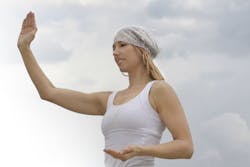Raise awareness of blood pressure screenings among dental patients and consider tai chi
By Eileen Morrissey, RDH, MS
Do you provide blood pressure screenings for your patients at their dental hygiene recare visits? Today’s dental hygiene students are trained to do so at every recall. A traditional cuff and stethoscope are used, and established guidelines limit treatment of patients who fall out of the range of what is considered safe.
The rationale for providing this service is clear, yet in the private practice setting it often falls by the wayside. Hypertension is known as the silent killer because symptoms are almost always absent. Since many patients do not routinely see their physicians, they often are not aware of the disease. Yet these same patients frequent our dental practices, and this is the perfect opportunity for us to provide the service quickly and easily. Lives can potentially be saved. There are countless stories about patients who were found to be hypertensive to the point of needing an emergency room referral. I have experienced this with patients.
A wrist monitor allows for an accurate digital readout of pulse and blood pressure in less than one minute. It eliminates the need for patients to have to roll up their bulky sleeves. Remember, this is a simple screening that allows us to inform a patient if he or she needs to follow up, either by having the pressure checked again, seeing a physician, or worst case, going to the ER.
In my experience, patients are happy to have their pressures taken. We provide the reading on a “Hygiene Progress Report” so patients can have it for their personal records. In subsequent appointments, I find that they are anxious to compare that day’s reading with the previous visit.
On a related note, we often see patients who experience early and moderate hypertension who are choosing not to be medicated. I have walked in these shoes. I am forever an explorer of alternative medicine, and I’m wary of being placed on a medication that I will likely be married to for a lifetime.
For those who think like me, I’ll share my experience with an alternative approach that has been extremely helpful. Disclaimer: I am not offering this as a substitute for medical counsel for anyone. It’s simply my story.
I was trained in transcendental meditation 20 years ago, and I practice it faithfully. Evidence-based research (EBR) documents that meditation, as well as yoga (which I also practice), can be helpful in lowering blood pressure. Nonetheless, being genetically predisposed and undergoing a generous amount of stress over the past few years, I found my blood pressure readings were steadily rising. My doctor warned me that I would likely need medication.
I’m not the best at following the advice of my physician. I’m guilty of being more of a “do as I say and not as I do” type person. I know I could be a better health-care role model. I had read EBR about the practice of tai chi and its results in lowering blood pressures; hence, I decided to attend a class. It was enjoyable, but I tend to like to do my own thing at home.
I googled “tai chi beginner moves” and found a 10-minute YouTube video. All the motions were ones that I had been taught in the class. For the past 16 months, I have engaged in a regimen of 15 minutes of tai chi practice a half hour before bedtime. I choose the same five movements, doing each for three minutes. I’m very faithful to this practice. Tai chi movements are very simple to do; the challenge is to do them in such slow motion. Those of us who are accustomed to being Type A exercisers may have some trouble at first. My advice: slow down!
My results have been nothing short of phenomenal. At my worst hypertensive moments over the past two years, I was at 155/94. This happened more than a few times, raising legitimate concerns with my physician.
I self-monitor and have watched my BP readings gradually decrease over the past year. I finally stopped checking because I could sense the difference in my body. When my BP is high, I can “feel” my blood racing. There is a pounding sensation around my ears. Not good, I know, and thankfully, it has stopped. Note: I’ve made no dietary changes. I’ve partaken regularly in aerobic and weight-bearing exercise throughout my adult life. This, along with meditation, yoga, eating in a somewhat healthy fashion, are my staples. Despite all this, my pressure was rising. Enter tai chi!
Last week, at my medical visit, my reading was officially 120/78. What?! I could not be more thrilled. I have added tai chi to the disciplines I practice, and I intend to keep it in my life forever.
You may have patients like me, who balk at the idea of taking prescription medicine. I’ve always felt that for me personally, it doesn’t hurt to try the alternative route first. Yes, I know my approach is not necessarily applicable or advocated by all, especially not by physicians who espouse traditional solutions and who are doing their best to keep patients healthy. Before you attack me, my way is simply an alternative strategy to health and well-being that happens to be working for me, right now.
Onward we go; it is in our hearts’ core! RDH
EILEEN MORRISSEY, RDH, MS, is a practicing clinician, speaker, and writer. She is an adjunct dental hygiene faculty member at Rowan College at Burlington County. Eileen offers CE forums to doctors, hygienists, and their teams. Reach her at [email protected] or 609-259-8008. Visit her website at www.eileenmorrissey.com.

